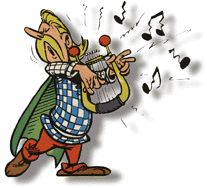 |
Musical Instruments of Antiquity as Illustrated in
|  |

Part 3: The Carnyx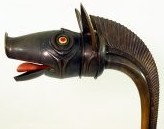 The Carnyx was a brass musical instrument used as a psychological weapon of war by the ancient Celts between 300BC and 200AD. The carnyx consisted of a 12 foot long thin bronze tube, bent at right angles at both ends. The lower end terminated in a mouthpiece, and the upper end flared out into a bell which was most often decorated to look like the had of a wild boar. Historians believe it likely had a tongue which would flap up and down increaseing the noise produced by the instrument. The carnyx was played in an upright position so that the boar's head bell protruded well above the heads of the warriors. It's primary purpose was to increase the level of noise and confusion on the battlefield. The Roman historian Diodorus Siculus wrote, "Their trumpets are also of a peculiar and barbaric kind which produce a harsh, reverberating sound suitable to the confusion of battle." Julius Caesar faced them when he invaded Gaul, and Claudius encountered them when he invaded Britain.
The Carnyx was a brass musical instrument used as a psychological weapon of war by the ancient Celts between 300BC and 200AD. The carnyx consisted of a 12 foot long thin bronze tube, bent at right angles at both ends. The lower end terminated in a mouthpiece, and the upper end flared out into a bell which was most often decorated to look like the had of a wild boar. Historians believe it likely had a tongue which would flap up and down increaseing the noise produced by the instrument. The carnyx was played in an upright position so that the boar's head bell protruded well above the heads of the warriors. It's primary purpose was to increase the level of noise and confusion on the battlefield. The Roman historian Diodorus Siculus wrote, "Their trumpets are also of a peculiar and barbaric kind which produce a harsh, reverberating sound suitable to the confusion of battle." Julius Caesar faced them when he invaded Gaul, and Claudius encountered them when he invaded Britain.
| |
   
| |
| In Asterix and the Big Fight a carnyx is used to announce the arrival of a neighboring chieftan. Notice how closely Uderzo's drawing of the carnyx head matches the photograph of the Deskford Carnyx unearthed in the North East of Scotland around 1816. |


|
| A similar instrument, only without the boar's head bell, was the lur. As shown in the photograph at right, the lur is essentiall a long trumpet bent in to a curve so that the bell is raised high in the air above the head of the player. They were usually made in pairs facing in opposite directions. In Asterix and the Big Fight a pair of lur are seen alongside two carnyx when a visiting chief arrives in Asterix's villiage. |


|
|
In Asterix in Belgium the Belgians are seen using a carnyx to sound the charge into battle.
Goscinny and Uderzo clearly differentiate the differences in musical playing styles between the Gauls and Belgians. The Belgian carynx makes the sound "whooohooo" while the Gaulish carnyx is played "booaahoooooooo".
|
 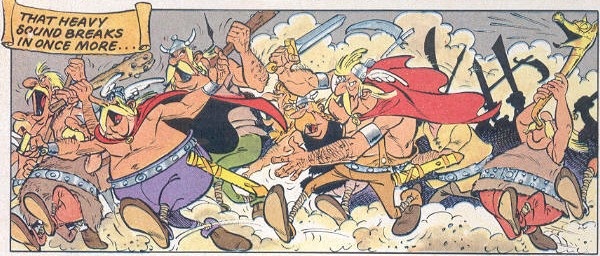
|
| In Asterix and the Actress Uderzo demonstrated that in addition to its use as a weapon of psychological warfare, the carnyx could also be used in more peaceful situations. In this scene, the carnyx is part of an lively ensemble accompanying the town dance. |

|
|
In Asterix and the Normans we see that in addition to its use as a musical instrument, the carnyx also came in handy as a weapon . . . . . which might explain the lack of complete well-preserved specimens in archeological digs.
|
 
|
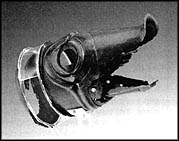 Only five fragments of this ancient instrument have been found, the finest being unearthed in Deskford, Scotland in 1816. The Deskford carnyx (at right) only has the boar's head bell and is missing the mane, tongue, and tubing. Images of carnyx players have been found as well. A Roman denarius, dating from 48 BC bears a representation of a carynx (below left). Three carnyx players are featured prominently on the Gundestrup Cauldron (below, second from left), which was found in a Danish peat bog. In recent years modern replicas of ancient carnyx have been featured in recordings by trombonist
Only five fragments of this ancient instrument have been found, the finest being unearthed in Deskford, Scotland in 1816. The Deskford carnyx (at right) only has the boar's head bell and is missing the mane, tongue, and tubing. Images of carnyx players have been found as well. A Roman denarius, dating from 48 BC bears a representation of a carynx (below left). Three carnyx players are featured prominently on the Gundestrup Cauldron (below, second from left), which was found in a Danish peat bog. In recent years modern replicas of ancient carnyx have been featured in recordings by trombonist 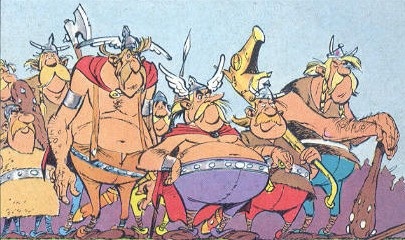
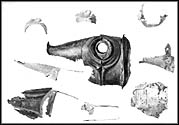
 Music in Asterix TOC
Music in Asterix TOC